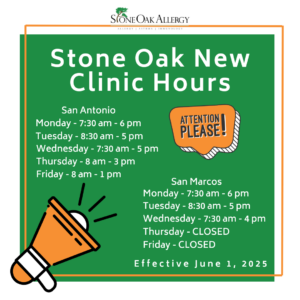October 22, 2025
The Hidden Workplace Allergens Making You Sick (And How to Fight Back)

Ever notice that your nose starts running or your head feels foggy the minute you step into the office—but clears up when you leave? You’re not imagining things. While outdoor pollen often gets the blame, the real problem might be closer than you think: hidden workplace allergens.
At Stone Oak Allergy, we often hear from patients who feel fine at home but miserable at work. From dust mites hiding in your office chair to mold growing quietly in the HVAC system, and even cockroaches, these unseen irritants can trigger everything from sneezing fits to fatigue, and may even cause or worsen asthma. If not properly managed, workplace allergens can adversely affect your health and safety. The good news? Once you know where to look (and how to protect yourself), you can fight back and reclaim your comfort and productivity.
The Real Allergy Villains Are Closer Than You Think
As fall fades and the cooler months settle in, many people expect their allergy symptoms to ease up—but that’s not always the case. When windows close and heaters kick on, indoor allergens often become the real troublemakers. These invisible irritants thrive in the places we spend most of our time—especially at work—triggering sneezing, congestion, itchy eyes, and even fatigue.
Common culprits include dust mites, pet dander, and mold spores, along with pollen that sneaks in on coats and shoes before settling into carpets and furniture. As air circulation decreases and humidity shifts, these allergens become more concentrated—especially in offices with recycled air or older HVAC systems.
The result? A rise in allergy symptoms just as you’re spending more time indoors. But there’s good news: a few simple steps—like keeping your workspace clean, using HEPA filters, and maintaining your building’s ventilation—can make a huge difference.
If you’ve noticed that your sniffles seem to follow you to work, it’s time to look closer at your indoor environment. Controlling allergens where you spend your day can help you feel clearer, more comfortable, and ready to take on the season.
The Sneaky Culprits Lurking in Your Office
Dust Mites and Office Carpeting
Dust mites love warm, fabric-covered places like carpets, upholstered chairs, cubicle walls, and box springs. They thrive on dead skin cells and humidity—two things most offices have plenty of. The result? Sneezing, congestion, itchy eyes, and that “can’t-stop-rubbing-my-nose” feeling that makes meetings unbearable.
Fight back: Ask about routine deep cleaning or consider air purifiers with HEPA filters to help trap these microscopic freeloaders.
Mold and Mildew in HVAC Systems
As the temperatures drop and the heat comes on, many offices unknowingly create the perfect environment for mold and mildew to thrive. When condensation builds up inside heating ducts, drip pans, or around older vents, tiny mold spores can circulate through the air—straight into your lungs. Because we spend more time indoors in the fall and winter, exposure levels can increase even in spaces that look spotless.
Warning signs: Persistent coughing, throat irritation, headaches, or that unmistakable musty odor that lingers near vents or in break rooms.
Fight back: Have building maintenance inspect and service HVAC systems before the heavy heating season begins. Replace filters regularly, repair leaks promptly, and use a dehumidifier if your workspace tends to feel damp. Keeping humidity between 30–50% makes it harder for mold to grow—and easier for everyone to breathe comfortably all winter long.
Cleaning Products and Chemical Sensitivities
Think “lemon fresh” means clean air? Think again. Many cleaning sprays and disinfectants contain volatile organic compounds (VOCs), chemicals, and chemical allergens that can irritate your nose, throat, and lungs. Exposure to these substances can also cause contact dermatitis and skin irritation, especially for those with sensitivities.
Fight back: Choose fragrance-free, low-VOC cleaning supplies. Air fresheners are another common source of fragrances and chemical allergens that can trigger sensitivities—opt for proper ventilation and avoid their use when possible. Even better, advocate for green cleaning policies in your workplace.
Perfumes and Personal Fragrances
A coworker’s favorite perfume or aftershave might smell pleasant to them—but to sensitive noses, it can trigger headaches, dizziness, common symptoms such as watery eyes, or even hives. In some cases, exposure to personal fragrances may even lead to an allergic reaction.
Fight back: Encourage a fragrance-free workplace or gently start the conversation about scent sensitivity. Most people are understanding once they realize how their favorite scent affects others.
Office Pets (and Pet Dander from Home)
Even if your office doesn’t allow animals, dander can travel in on clothing or bags from pet owners. It clings to fibers, floats through the air, and can linger for days. For those with pet allergies, even small amounts of pet dander can trigger symptoms such as a stuffy nose, sneezing, or itchy eyes—similar to how pollen allergies can affect people when outdoor allergens enter indoor spaces.
Fight back: HEPA-filtered vacuums and air purifiers help, as do frequent cleanings and designated “pet-free” zones for those with strong sensitivities. Like with pollen allergies, minimizing exposure indoors is key for managing symptoms.
How Workplace Allergies Impact Your Health and Productivity
When you’re constantly battling itchy eyes, sinus pressure, brain fog, or even difficulty breathing, focusing on work becomes an uphill climb. Allergy symptoms can easily be mistaken for colds or stress, meaning many people never realize their office could be to blame.
Untreated allergies don’t just make you uncomfortable—they can drain your energy, lower productivity, and increase absenteeism. In some cases, ongoing exposure to allergens can contribute to respiratory diseases, especially in environments like the industrial sector where air quality issues are common. Tackling allergens head-on leads to clearer thinking, better mood, and fewer “I just can’t today” moments.
How to Fight Back Against Hidden Allergens
Improve Indoor Air Quality
Clean air equals clear sinuses—and your office HVAC system plays a major role in that. Regular maintenance, managing outdoor air intake, and using air conditioning to control humidity and filter airborne allergens can dramatically reduce exposure to irritants.
According to Innovative Comfort Solutions, a leading HVAC design and installation partner in Atlanta, UV light filtration systems are becoming one of the most effective tools for improving indoor air quality. These systems use ultraviolet light to neutralize bacteria, mold spores, and viruses as air circulates through the ducts—helping create a cleaner, healthier environment before the air ever reaches your workspace.
Pairing UV filtration with HEPA filters, ionization technology, and routine system inspections ensures that the air you breathe is as fresh as possible. If you can, keep a small air purifier near your desk—it’s a quiet, powerful defense against dust, dander, and other airborne allergens that can cause discomfort throughout the day.
Practice Smart Desk Hygiene
Wipe down every surface on your desk, including your keyboard and phone, daily (yep, even your mouse), to reduce allergen buildup. Avoid storing old papers or cardboard boxes under your desk—they’re dust mite magnets.
Choose Allergy-Friendly Cleaning Products
Opt for unscented or hypoallergenic cleaning solutions and avoid harsh aerosols, as these help you avoid chemicals and chemical allergens that can trigger reactions. Even switching to microfiber cloths can reduce airborne dust.
Address Building Maintenance Issues
Don’t ignore leaks, water stains, or that funky smell in the breakroom ceiling. Mold can start growing within 24–48 hours of moisture exposure, and sometimes it can be hidden behind the wall. Report it early—it’s not just building maintenance’s problem; it’s a health issue.

Talk to an Allergist
If symptoms persist, it’s time to get tested. At Stone Oak Allergy, our specialists can help you pinpoint exactly what’s causing your reactions so your treatment plan—whether medication, avoidance strategies, or immunotherapy—actually works.
Allergy testing is quick, safe, and incredibly revealing. Common testing options include:
- Skin Prick Testing – A small amount of potential allergen is applied to the skin (usually on the forearm or back). If you’re allergic, a small bump or redness will appear within minutes. It’s the most common and effective way to detect environmental and food allergens.
- Intradermal Testing – Used when a more sensitive test is needed. A small amount of allergen is injected just under the skin to confirm specific sensitivities—often for insect stings or medication allergies.
- Patch Testing – Designed for contact allergies (like reactions to fragrances, metals, or cleaning products). Adhesive patches with allergens are placed on the skin and worn for 48 hours to see if a rash develops.
- Blood Testing (IgE or RAST Test) – Ideal for patients who can’t undergo skin testing. A simple blood draw measures allergen-specific antibodies to identify triggers such as pollen, dust mites, pet dander, or mold.
Each method helps build a clear picture of your allergic profile, so you can take targeted steps toward lasting relief—at work and beyond. Similar findings have been reported in research from other regions, such as Europe, highlighting consistent workplace allergen exposure among workers.

Overcoming Allergy Challenges
Tackling allergy challenges in the workplace isn’t just about treating symptoms—it’s about getting proactive with your environment. The first step is understanding where indoor allergens are coming from and how they’re affecting you. Once you know your triggers, you can take targeted action to reduce exposure and reclaim your workspace.
Start by identifying potential hotspots for allergens, such as shared office equipment, break rooms, and high-traffic areas. Simple changes like using a damp cloth to wipe down surfaces, choosing washable curtains, and keeping personal items off the floor can help minimize dust and pet dander buildup. If you notice signs of mold or water leaks, report them promptly to prevent mold growth from taking hold.
Don’t forget the power of communication—let your employer or building manager know about your allergy concerns. Many workplaces are willing to make adjustments, such as improving air filtration or switching to hypoallergenic cleaning products, to support employee health. By staying informed and advocating for a cleaner, healthier environment, you can overcome allergy challenges and breathe easier every day.
The Role of the Asthma and Allergy Foundation of America (AAFA)
When it comes to managing allergies, you’re not alone—organizations like the Asthma and Allergy Foundation of America (AAFA) are dedicated to supporting individuals and workplaces in the fight against indoor allergens. AAFA plays a crucial role in raising awareness about the impact of allergies, providing up-to-date information on common triggers, and advocating for better indoor air quality standards.
Through research, education, and community outreach, AAFA helps people recognize the signs of allergic reactions and understand the importance of controlling indoor allergens. They offer resources on everything from allergy-friendly cleaning practices to the latest treatments, such as allergy shots and over-the-counter medications. Their advocacy even extends to improving air quality policies in schools, offices, and public spaces.
By tapping into the knowledge and support offered by AAFA—and partnering with local specialists like Stone Oak Allergy—you can stay informed, reduce exposure, and take meaningful steps toward a healthier, more comfortable environment for everyone.
Creating a Healthier Work Environment for Everyone
You may not be able to overhaul the entire office ventilation system—but you can make small changes that improve your daily comfort and help coworkers who struggle with similar issues. Workplace wellness starts with awareness and teamwork.
Try simple, realistic steps like:
- Starting the conversation. If you notice musty smells, visible dust buildup, or heavy fragrances in the office, bring it up respectfully with your manager or HR.
- Leading by example. Keep your workspace clean, skip the perfume or cologne, and choose unscented wipes or cleaners.
- Supporting coworkers. Allergies can affect anyone—sometimes in ways that aren’t obvious. Encouraging a scent-free, considerate culture helps everyone breathe easier.
- Suggesting a checkup. Sometimes, just mentioning that allergy testing helped you find relief can inspire others to do the same.
A healthier workplace doesn’t always require big changes—it just takes a few people paying attention and caring enough to act. Partnering with professional HVAC experts—like Innovative Comfort Solutions, who specialize in advanced air purification and UV filtration systems—can make a big difference in shared workspaces where clean, healthy air matters most.
Take Control of Your Indoor Health
If your workdays are filled with sneezes, headaches, or fatigue, you don’t have to just “push through it.” Hidden allergens can have a serious impact on your comfort and well-being—but they’re also highly manageable once identified.
Small changes can go a long way:
- Add a desk-sized air purifier to your workspace.
- Keep personal items dust-free.
- Ask about routine building maintenance and cleaning schedules.
- Avoid heavily scented products or sprays.
- And most importantly—get tested if you suspect allergens are the cause.
At Stone Oak Allergy, our specialists can help you pinpoint what’s triggering your symptoms and design a personalized plan to help you feel better—whether that means allergy shots, medication, or practical guidance for reducing exposure at work and home.
Don’t let hidden allergens control your day—or your comfort. You deserve to breathe easier, feel more energized, and enjoy every part of your life—including your workday.
